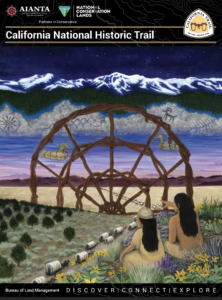
The American Indian Alaska Native Tourism Association and Bureau of Land Management National Scenic and Historic Trails Program Unveil California National Historic Trail Poster at Nevada Native Art Recognition Event
Great Basin Desert Artist Cassandra Garback is honored for her tribal artwork with launch of the new California National Historic Trail Poster
RENO, Nev. (December 20, 2024) – As part of a collaborative partnership between the American Indian Alaska Native Tourism Association (AIANTA) and the Bureau of Land Management (BLM) National Scenic and Historic Trails program, the selected Great Basin tribal artwork for the California National Historic Trail poster was unveiled by artist Cassandra Garback during a celebratory event at the Nevada Museum of Art in Reno, Nevada on December 19.
Through the partnership, AIANTA is working with tribes adjacent to the California National Historic Trail in Nevada to develop cultural heritage content and itineraries with a focus on telling a more inclusive story of the ancestral lands along the California Trail and the impact it had on Nevada’s Native people. As part of this goal, a Nevada Native artist was selected through a poster contest to illustrate a more inclusive narrative of the trail – one that tells the story of multiple peoples and perspectives.
The artist, Cassandra Garback, is an Indigenous artist born and raised in Nevada, specifically near Pyramid Lake in the Great Basin Desert. The breathtaking landscapes and rich cultural heritage of this region have had a profound impact on her artistic expression. As she immersed herself in the vibrant colors, textures, and stories of this land, she aimed to capture its essence through her art. The Great Basin Desert holds a unique beauty, one that is both harsh and delicate, resilient and powerful. Cassandra’s artwork reflects the intricate relationship between the land and its people, paying homage to the land itself, ancient traditions and wisdom passed down through generations. Through her paintings, and jewelry, she hopes to convey the deep connection we have with our environment and culture, inspiring others to appreciate and protect the natural world that sustains us all.
“This collaboration between the Bureau of Land Management’s National Scenic and Historic Trails program and the American Indian Alaska Native Tourism Association (AIANTA) reinforces the importance of promoting Indigenous storytelling and amplifying Indigenous voices,” said AIANTA CEO Sherry L. Rupert. “By sharing her vision through this stunning artwork, Cassandra Garback has not only brought the spirit of the Great Basin to life but has also deepened our collective understanding of Indigenous cultures and their profound connection to these cherished landscapes.”
The story of the California Trail is usually told from the perspective focusing on the journey it took for westward migrants to travel over 5,000 miles from Missouri to California. However, the land they crossed was far from empty and the greatest migration in U.S. history is a story of over 250,000 diverse travelers crossing the ancestral lands of hundreds of Indigenous groups. In Nevada, Indigenous peoples present during the historic period of the trail, and still connected to the land today, include the Washoe (Waší∙šiw), Northern Paiute (Numu), Western Shoshone (Newe), Southern Paiute (Nuwuvi), and Goshute (Kutsipiuti) people.
“My goal is to transport viewers on a journey through Nevada’s diverse heritage, just as the California Trail has done for generations,” said artist Cassandra Garback. “My hope is that this artwork will encourage viewers to visit the California Trail and its beauty for themselves.”
The Nevada Native Art Recognition Event of the California National Historic Trail Poster was held at the Nevada Museum of Art with a drum song by the Eagle Wing Dancers and an honor song by Reno Sparks Indian Colony Tribal Council Member, Toby Stump, and remarks by AIANTA CEO Sherry L. Rupert, Artisan Cassandra Garback, Nevada’s Indian Territory Chairperson Bethany Sam, and Nevada State Director of BLM Jon Raby.
Native Nations and communities who are looking to start or expand their cultural tourism footprint can find resources at www.aianta.org and visitors interested in learning more about Native culture can visit www.nativeamerica.travel.
About AIANTA:
For more than 26 years, the American Indian Alaska Native Tourism Association (AIANTA) has served as the only national organization dedicated to advancing cultural heritage tourism in Native Nations and communities across the United States. Established by tribes for tribes to address inequities in the tourism system, AIANTA is a 501(c)(3) national nonprofit governed by an all-Native board of directors and serves as a united voice for the $15.7 billion Native hospitality sector. AIANTA’s successful legislative work led to the industry-changing Native American Tourism and Improving Visitor Experience Act (NATIVE Act) funding in 2018, as Indian Country Tourism was recognized through federal appropriations via NATIVE Act implementation. AIANTA’s mission is to define, introduce, grow, and sustain American Indian, Alaska Native and Native Hawaiian (AIANNH) tourism that honors traditions and values while helping AIANNH businesses become market/export ready for domestic and international markets. Visit www.aianta.org to learn more.
Media Contact:
Liz Slobodian, APR
Liz@shipwrightcommunications.com
Photo 1:
Photo Credit: AIANTA // Caption – California National Historic Trail Poster
Photo 2:
Photo Credit: Cassandra Garback // Caption – Artist Cassandra Garback
